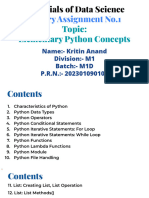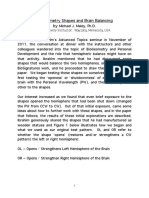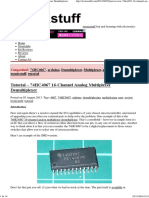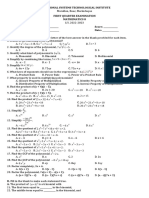" A Puzzle A Day To Learn, Code, and Play " Visit: True False True False and Not Not and or
Uploaded by
Dario R" A Puzzle A Day To Learn, Code, and Play " Visit: True False True False and Not Not and or
Uploaded by
Dario RPython Cheat Sheet: Basic Data Types
“A puzzle a day to learn, code, and play” → Visit finxter.com
Description Example
Boolean The Boolean data type is a truth value, either ## 1. Boolean Operations
True or F alse. x, y = True, False
print(x and not y) # True
The Boolean operators ordered by priority: print(not x and y or x) # True
not x → “if x is False, then x, else y”
x and y → “if x is False, then x, else y” ## 2. If condition evaluates to False
x or y → “if x is False, then y, else x” if None or 0 or 0.0 or '' or [] or {} or set():
# None, 0, 0.0, empty strings, or empty
These comparison operators evaluate to True: # container types are evaluated to False
1 < 2 and 0 <= 1 and 3 > 2 and 2 >=2 and
print("Dead code") # Not reached
1 == 1 and 1 != 0 # True
Integer, An integer is a positive or negative number ## 3. Arithmetic Operations
Float without floating point (e.g. 3). A float is a x, y = 3, 2
positive or negative number with floating point print(x + y) # = 5
precision (e.g. 3.14159265359). print(x - y) # = 1
print(x * y) # = 6
The ‘//’ operator performs integer division. print(x / y) # = 1.5
The result is an integer value that is rounded print(x // y) # = 1
toward the smaller integer number print(x % y) # = 1s
(e.g. 3 // 2 == 1). print(-x) # = -3
print(abs(-x)) # = 3
print(int(3.9)) # = 3
print(float(3)) # = 3.0
print(x ** y) # = 9
String Python Strings are sequences of characters. ## 4. Indexing and Slicing
s = "The youngest pope was 11 years old"
The four main ways to create strings are the print(s[0]) # 'T'
following. print(s[1:3]) # 'he'
print(s[-3:-1]) # 'ol'
1. Single quotes print(s[-3:]) # 'old'
'Yes' x = s.split() # creates string array of words
2. Double quotes print(x[-3] + " " + x[-1] + " " + x[2] + "s")
"Yes"
# '11 old popes'
3. Triple quotes (multi-line)
"""Yes
## 5. Most Important String Methods
We Can"""
y = " This is lazy\t\n "
4. String method
print(y.strip()) # Remove Whitespace: 'This is lazy'
str(5) == '5' # True
print("DrDre".lower()) # Lowercase: 'drdre'
5. Concatenation
print("attention".upper()) # Uppercase: 'ATTENTION'
"Ma" + "hatma" # 'Mahatma'
print("smartphone".startswith("smart")) # True
print("smartphone".endswith("phone")) # True
print("another".find("other")) # Match index: 2
These are whitespace characters in strings.
print("cheat".replace("ch", "m")) # 'meat'
● Newline \ n
print(','.join(["F", "B", "I"])) # 'F,B,I'
● Space s
\
print(len("Rumpelstiltskin")) # String length: 15
● Tab t
\ print("ear" in "earth") # Contains: True
You might also like
- Jan Przewoznik and Marek Soszynski - How To Think in ChessNo ratings yetJan Przewoznik and Marek Soszynski - How To Think in Chess288 pages
- Basic Data Structures Keywords: Types Evaluate To FalseNo ratings yetBasic Data Structures Keywords: Types Evaluate To False7 pages
- 1 2 3 4 5 6 7 8 9 Merged Programming PythonNo ratings yet1 2 3 4 5 6 7 8 9 Merged Programming Python9 pages
- Basic Data Structures Keywords: Types Evaluate To FalseNo ratings yetBasic Data Structures Keywords: Types Evaluate To False8 pages
- PYTHAN OPN CheatSheet-Python-1 - Keywords1 (1) - MergedNo ratings yetPYTHAN OPN CheatSheet-Python-1 - Keywords1 (1) - Merged15 pages
- Python - 10 Marks Sol. of Previous PUT_Bharat_AggNo ratings yetPython - 10 Marks Sol. of Previous PUT_Bharat_Agg43 pages
- Representing Data - Booleans and StringsNo ratings yetRepresenting Data - Booleans and Strings5 pages
- Httpsamathuba - Uct.ac - zad2llecontent45512topicsfilesdownload1844970DirectFileTopicDownload 6No ratings yetHttpsamathuba - Uct.ac - zad2llecontent45512topicsfilesdownload1844970DirectFileTopicDownload 647 pages
- HandNote 2-STRING LIST TUPLE DICTIONARYNo ratings yetHandNote 2-STRING LIST TUPLE DICTIONARY64 pages
- Uncorrected Proofs: Rogier Noldus Ftoc - Tex V1 - December 6, 2005 6:39 P.MNo ratings yetUncorrected Proofs: Rogier Noldus Ftoc - Tex V1 - December 6, 2005 6:39 P.M6 pages
- R2-200xxxx Clarification On PDSCH Rate-Matching Capabilities - v1No ratings yetR2-200xxxx Clarification On PDSCH Rate-Matching Capabilities - v110 pages
- Lev Polugaevsky - Hug-Polugaevsky - Biel 1986No ratings yetLev Polugaevsky - Hug-Polugaevsky - Biel 19864 pages
- Hanan W Russell - Russian For ChessplayersNo ratings yetHanan W Russell - Russian For Chessplayers53 pages
- Isaac Lipnitsky - Reshevsky-Ragozin - Semmering 1937No ratings yetIsaac Lipnitsky - Reshevsky-Ragozin - Semmering 19376 pages
- Vladimir Bagirov - Tal-Timman - 3rd Match Game - Hilversum 1988 PDFNo ratings yetVladimir Bagirov - Tal-Timman - 3rd Match Game - Hilversum 1988 PDF3 pages
- Ben Graham Calculations Template - FinboxNo ratings yetBen Graham Calculations Template - Finbox8 pages
- Garry Kasparov - London-Leningrad Championship Games100% (1)Garry Kasparov - London-Leningrad Championship Games143 pages
- Stories From Tagore by Rabindranath Tagore - The Postmaster100% (1)Stories From Tagore by Rabindranath Tagore - The Postmaster4 pages
- 1988 Krishna Janmashtami, Gokulashtami Puja Date and Fasting Time For New Delhi, NCT, India 2No ratings yet1988 Krishna Janmashtami, Gokulashtami Puja Date and Fasting Time For New Delhi, NCT, India 21 page
- Liceul Teoretic "Mihail Sadoveanu" Manual: Upstream Upper Intermediate B2+ Clasa: 10G 3 Ore/săptămână Profesor: Cristina Ioana NistorNo ratings yetLiceul Teoretic "Mihail Sadoveanu" Manual: Upstream Upper Intermediate B2+ Clasa: 10G 3 Ore/săptămână Profesor: Cristina Ioana Nistor5 pages
- Technical Note: MVI56 (E) - MNETR Add-On Instruction Installation GuideNo ratings yetTechnical Note: MVI56 (E) - MNETR Add-On Instruction Installation Guide13 pages
- Was A Common Sight in Japan To See Circulating Libraries Carried From House To House On The Backs of MenNo ratings yetWas A Common Sight in Japan To See Circulating Libraries Carried From House To House On The Backs of Men8 pages
- Tutorial - 74HC4067 16-Channel Analog Multiplexer DemultiplexerNo ratings yetTutorial - 74HC4067 16-Channel Analog Multiplexer Demultiplexer14 pages
- Colegio de San Juan de Letran-Calamba: DEPARTMENT: Basic Education Department - High SchoolNo ratings yetColegio de San Juan de Letran-Calamba: DEPARTMENT: Basic Education Department - High School8 pages
- Lacanian Fantasy The Image Language and Uncertainty 1st Edition Kirk Turner - Download the entire ebook instantly and explore every detail100% (1)Lacanian Fantasy The Image Language and Uncertainty 1st Edition Kirk Turner - Download the entire ebook instantly and explore every detail52 pages
- Stories of Speculation Year 11 Advanced EnglishNo ratings yetStories of Speculation Year 11 Advanced English5 pages













































































































